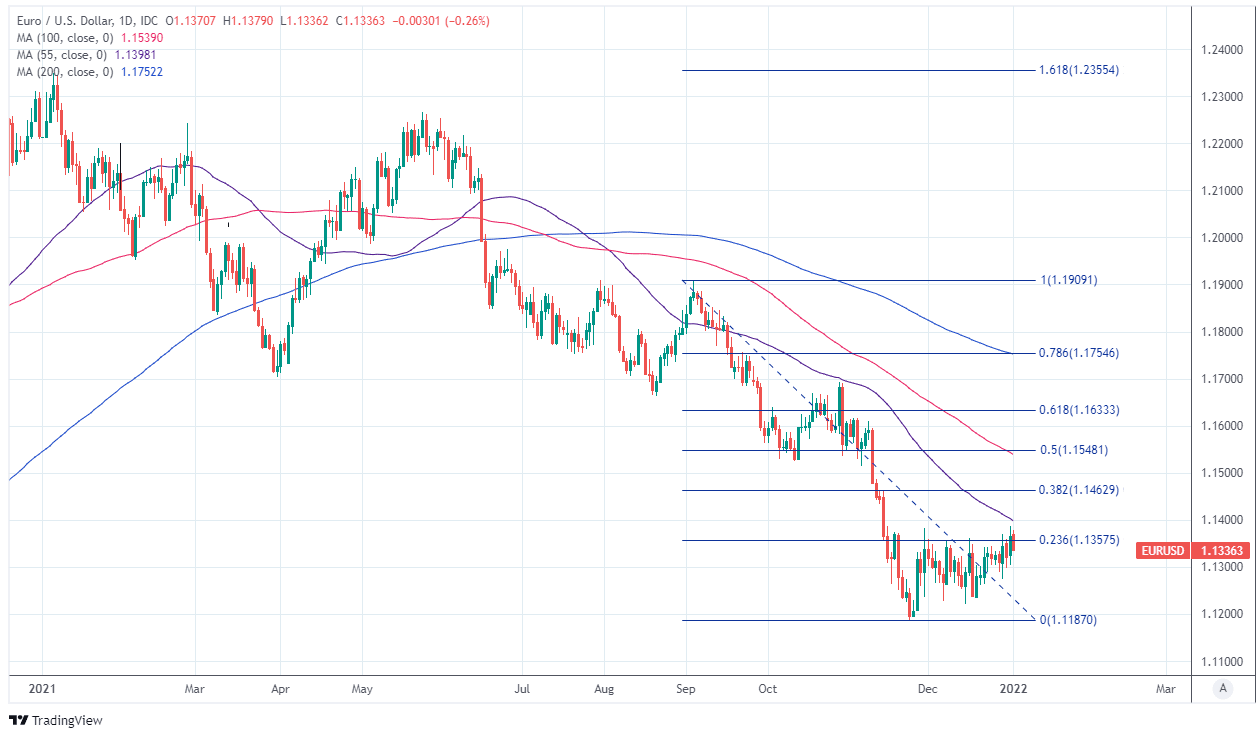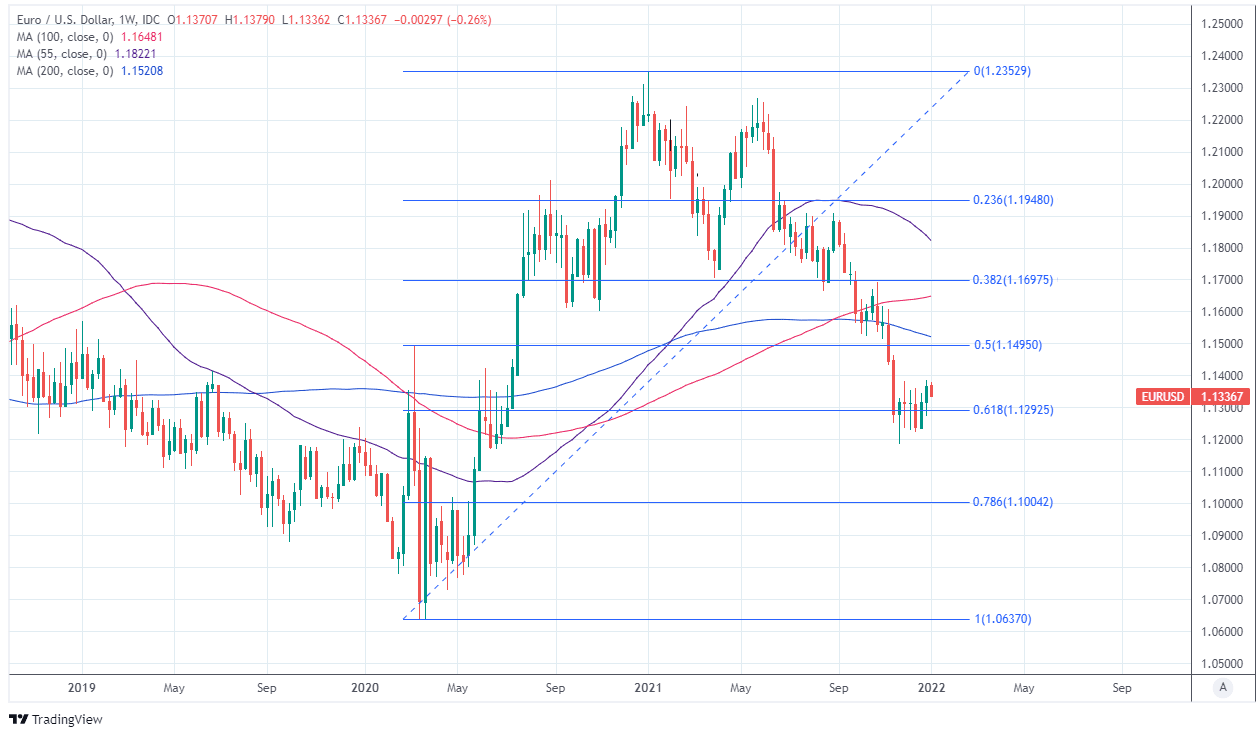Euro / Dollar Week Ahead Forecast: Battling to Hold 1.13 in Data Heavy Week
- Written by: James Skinner
-
- EUR/USD supported above 1.13 & 1.1260
- As EUR eyes EZ CPI, key U.S. data loom
- EUR/USD could attempt 1.14 multi-week
- If USD demand ebbs further early in Jan

Image © Adobe Images
The Euro to Dollar rate entered the new year close to six week highs on Monday but would have a battle on its hands to hold above the nearby 1.13 handle if the greenback returns onto its front foot in what is an action-packed week ahead for U.S. and European economic data.
Europe’s single currency benefited from an ebbing market appetite for the U.S. Dollar over the festive holidays and into the new year, which saw the Euro-Dollar rate lifted to highs of 1.1387 as the curtain closed on 2021.
However, this leaves the Euro-Dollar rate susceptible to any renewed bid for the greenback as trading conditions normallise over the coming week, which is something that could be encouraged by either of the major economic numbers due out of the U.S. and Europe in the days ahead.
“The key economic data releases this week are the ISM manufacturing report on Tuesday and the employment situation report on Friday,” says David Mericle, chief U.S. economist at Goldman Sachs.
“We believe the pre-Omicron payroll trend was much firmer than the 210k pace reported for November—perhaps as high as +600k—and we note that most of the virus-related slowdown in dining activity occurred after the December survey week,” Mericle and colleagues wrote in a Sunday briefing.
Above: Euro-Dollar rate shown at daily intervals with Fibonacci retracements of September’s extended move lower indicating possible areas of technical resistance to a further recovery.
- EUR/USD reference rates at publication:
Spot: 1.1286 - High street bank rates (indicative band): 1.0890-1.0970
- Payment specialist rates (indicative band): 1.1184-1.1230
- Find out about specialist rates and service, here
- Set up an exchange rate alert, here
The danger for the Euro this week is that either of the looming U.S. economic figures leads the market to more confidently anticipate an initial interest rate rise coming from the Federal Reserve as soon as March or April, a prospect that is yet to be fully priced-in by interest rate markets.
Institute for Supply Management PMI surveys of the manufacturing and services sectors will impact investors’ expectations of the U.S. economy for the final quarter but it’s Friday’s non-farm payrolls report that would have the greatest impact on the thinking of Federal Reserve (Fed) policymakers.
“We estimate nonfarm payrolls rose 450k in December,” says Goldman Sachs’ Mericle. “We estimate a one-tenth drop in the unemployment rate to 4.1%, reflecting a firm household employment gain and a stable or higher labor force participation rate—the latter driven by expiring UI benefits.”
Minutes of December’s Fed meeting will be scrutinised closely by the market on Wednesday for clues about the likelihood of a March or April increase in interest rates after the bank decided to accelerate the winding down of its quantitative easing programme so that it ends entirely in March.
This accelerating withdrawal of the Fed’s crisis-inspired monetary policy support was first signalled being on the way back in June and has been a key driver of the Euro-Dollar rate’s -7% decline for the 12 months to Monday, although European Central Bank (ECB) policy has also been an important factor too.
{wbamp-hide start}
{wbamp-hide end}{wbamp-show start}{wbamp-show end}
“We see continued weakening in the shared currency next year to the 1.10 mark and likely beyond as headwinds remain firmly in place, where only the (highly unlikely) chance that the ECB hikes in late-2022/early-2023 possibly provides some support,” says Juan Manuel Herrera, a strategist at Scotiabank, writing in a Friday research note.
The Fed warned in December that its interest rate could rise as many as three times this year to reign in U.S. inflation pressures while the ECB insisted that its interest rates are highly unlikely to change, citing expectations that European inflation pressures would fade of their own accord this year.
This latter assumption will be put to the test on Friday when official data is widely expected to show the Eurozone consumer price index slipping from annualised 4.9% to 4.8% for last month, and the Euro-Dollar rate is likely to be sensitive to the outcome.
Europe’s single currency could potentially find benefit any upside surprise on Friday if it leads to speculation about a possible acceleration of the ECB’s plan to phase out its own €1.85 trillion Pandemic Emergency Purchase Programme of quantitative easing.
“In good news for nervous policymakers, our central case is that eurozone inflation has already peaked (at a record high of 4.9% in November). Unless wholesale energy prices keep rising, it’s just maths that the large contribution they are making to inflation will drop out. And if global supply disruption eases in 2022, other cost pressures should also fall,” says Simon Wells, chief European economist at HSBC.
Above: Euro-Dollar rate shown at weekly intervals with Fibonacci retracements of 2020 recovery indicating likely areas of technical support for Euro.







